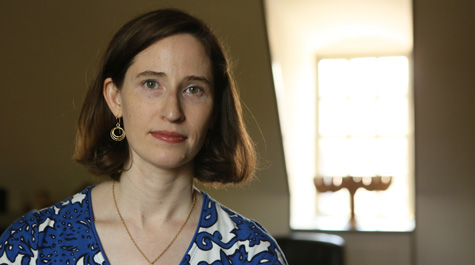Child survivors of war and the fine line between documentation and exploitation
The world let out a collective gasp when the horrifying image of 3-year-old Aylan Kurdi, who had drowned while attempting to reach safety in Turkey, was released in 2015.
“Even as a Holocaust researcher, used to reading disturbing details of atrocities, I was really shaken by that photograph – in part, because I have two young children,” said Maggie Fraser Kirsh, visiting assistant professor of Judaic studies at William & Mary.
Kirsh was not alone. She is, however, all too familiar with the scenario: For more than a decade, Kirsh has been researching child survivors of the Holocaust and the photos and stories of them that were documented and exploited following the war. In January, she’ll present the findings from her paper Publicity, Privacy, and Protection: The Ethics of ‘Advertising’ Child Survivors at a conference in London.
“The tension between protecting the privacy of child refugees and advertising their stories in order to raise awareness and funds is something that non-profits today must address, just as child welfare organizations did right after the Holocaust,” said Kirsh. “People are much more likely to donate to a cause if the issue has been personalized. Not with a generic story, but with specific details of a real individual in need. But, it’s important to make sure that such details are not used in a sensationalized way.”
In the 1940s on the heels of war, such images to elicit sympathy from the world were common. As Kirsh said, an event of this magnitude was unprecedented, and organizations struggled to raise both funds and volunteers.
“Nobody knew how to care for these children – is it better to talk to them about their past experiences, or is it better to just put it behind them and move on?” said Kirsh. “The people working with the children were very lost and had very little guidance in most cases.”
What kept the organizations and homes running were sympathy-fueled donations from around the world. Through newsletters, advertisements and programs to “sponsor” a child survivor in exchange for updates on their well being, the organizations shared photos and stories of the kids, struggling to strike a balance between feeding the world’s curiosity and respecting the privacy of the children.
There were also disparities in the way relief organizations from different regions portrayed children. In her research, Kirsh focused on organizations from Great Britain and Israel and found their propaganda to be markedly different.
“There’s a traditional narrative that has been told about the attitudes Israelis had toward Holocaust survivors,” said Kirsh. “They saw them as raw material that would help build a nation. So whereas in propaganda from Israel there’s a lot of emphasis on the children’s bodies and strength that will help build a country, in Britain they’re talking about the children being assimilated into the middle class and learning English. They tended to be quite quiet about their Jewish identity.”
In Britain, materials also tended to showcase very young children, even babies years after the war ended. In reality, most children who survived were much older.
“There was a feeling that donors would be more sympathetic if they saw an image of a 3 or 4-year-old kid who looks sweet and angelic as opposed to a moody teenager,” said Kirsh. “In both countries, there was also a fine line between portraying the children as desperately in need of help but not beyond redemption. They wanted to show they were confident the children were on the road to recovery.”
Amidst the wave of propaganda showcasing child survivors throughout Europe, some organizations remained much more tight-lipped on the welfare of their children. One such organization was Youth Aliyah, an organization established by Jewish Zionist leader Henrietta Szold that aided child refugees from Nazi Europe who settled in Palestine (later Israel).
“[Szold] was often pushed to provide the organization with detailed stories about the children for publicity purposes,” said Kirsh. “She consistently declined to speak for the children, calling their stories sacred and refusing to ‘put them on display’ – even if doing so would garner more donations.”
Szold had a valid argument for protecting the privacy of child survivors, but others argued (and continue to argue today) that leaving stories untold stifles awareness of a critical issue.
Kirsh acknowledges the need for awareness, but finds that perhaps there could be a way to share the stories of child refugees while keeping sensationalism at bay. A good example, she said, was seen in the Passover materials of the Religious Action Center of Reform Judaism following the death of Aylan Kurdi. As a tribute, they shared a story of young Aylan’s father buying bananas as a special treat for his sons, and suggested that Jews add a banana to their Passover seder “to remind us of Aylan, Galip [Aylan’s brother, who also drowned] and children everywhere who are caught up in this modern day exodus.”
“This type of commemoration keeps the stories of child refugees at the forefront, without putting them on display in an exploitative way,” said Kirsh.















